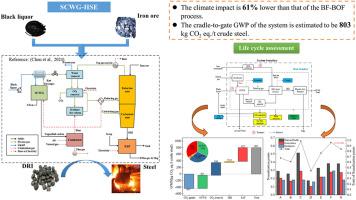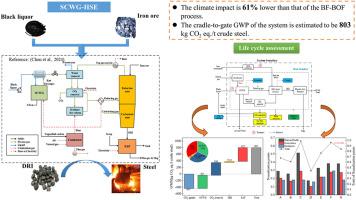超临界水气化与直接还原铁生产相结合工艺的生命周期评估
IF 9.7
1区 环境科学与生态学
Q1 ENGINEERING, ENVIRONMENTAL
引用次数: 0
摘要
寻找替代技术以减少钢铁行业的碳排放已成为当务之急。超临界水气化(SCWG)与制氢-竖炉-电弧炉(HSE)工艺相结合,提供了一种前景广阔的低碳替代技术。拟议路线通过超临界水气化技术将生物质转化为生物合成气,生产直接还原铁,然后通过电弧炉工艺生产粗钢。本研究使用生命周期评估(LCA)对 SCWG-HSE 工艺的环境影响进行了评估。生命周期评估使用 Gabi V9.2 软件和程序中的 Ecoinvent 3.6 数据库进行。结果发现,与传统的 BF-BOF 工艺相比,SCWG-HSE 工艺的全球升温潜能值降低了 61%,与煤气化-HSE 和天然气-HSE 工艺相比,降低了 28%-30%。它与基于可再生氢的 HSE 路线相当。据估计,拟议系统从摇篮到终点的全球升温潜能值为 803 千克二氧化碳当量/吨粗钢。在这一过程中,制氢和电弧炉环节是全球变暖潜势的主要来源。进一步分析表明,通过整合碳捕集与封存技术,可额外减少约 38% 的全球变暖潜势,而优化电力供应结构预计可减少高达 63% 的全球变暖潜势。这项研究不仅限于评估全球升温潜能值,还包括其他环境影响指标。结果表明,SCWG-HSE 流程在环境绩效方面具有巨大潜力。本文章由计算机程序翻译,如有差异,请以英文原文为准。


Life cycle assessment of a process integrating supercritical water gasification with direct reduced iron production
Finding alternative technologies to reduce carbon emissions of the steel industry has become a pressing concern. Supercritical water gasification (SCWG) combined with Hydrogen Production-Shaft furnace-Electric arc furnace (HSE) process offers a promising low-carbon alternative. The proposed route converts biomass to biosyngas through SCWG technology to produce direct reduced iron, followed by an electric arc furnace process to produce crude steel. In this study, the environmental impact of the SCWG-HSE process was evaluated using life cycle assessment (LCA). LCA was conducted using the Gabi V9.2 software, and the Ecoinvent 3.6 database within the program. It was found that the SCWG-HSE process has a 61 % lower global warming potential compared to the conventional BF-BOF process, and a 28 %–30 % reduction compared to the Coal gasification- HSE and Natural gas based- HSE processes. It is comparable to the renewable hydrogen-based HSE route. The cradle-to-gate global warming potential of the proposed system is estimated to be 803 kg CO2 eq./t crude steel. In the process, the hydrogen production and electric arc furnace segments are the main sources of global warming potential. Further analysis shows that an additional global warming potential reduction of about 38 % can be achieved by integrating Carbon Capture and Storage technologies, while optimization of the electricity supply structure is expected to achieve a global warming potential reduction of up to 63 %. This study is not limited to assessing global warming potential, but also covers other environmental impact indicators. The results show that the SCWG-HSE process has significant potential in terms of environmental performance.
求助全文
通过发布文献求助,成功后即可免费获取论文全文。
去求助
来源期刊

Journal of Cleaner Production
环境科学-工程:环境
CiteScore
20.40
自引率
9.00%
发文量
4720
审稿时长
111 days
期刊介绍:
The Journal of Cleaner Production is an international, transdisciplinary journal that addresses and discusses theoretical and practical Cleaner Production, Environmental, and Sustainability issues. It aims to help societies become more sustainable by focusing on the concept of 'Cleaner Production', which aims at preventing waste production and increasing efficiencies in energy, water, resources, and human capital use. The journal serves as a platform for corporations, governments, education institutions, regions, and societies to engage in discussions and research related to Cleaner Production, environmental, and sustainability practices.
 求助内容:
求助内容: 应助结果提醒方式:
应助结果提醒方式:


